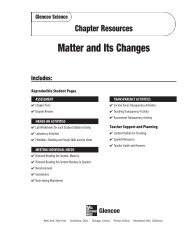Glenoce Science Level Red Study Guide - Glencoe
Glenoce Science Level Red Study Guide - Glencoe
Glenoce Science Level Red Study Guide - Glencoe
- No tags were found...
You also want an ePaper? Increase the reach of your titles
YUMPU automatically turns print PDFs into web optimized ePapers that Google loves.
Name Date ClassErosion of Earth’s Surface2<strong>Study</strong> <strong>Guide</strong>11Directions: Answer the following questions on the lines provided.1. What is the difference between weathering and erosion?Chapter2. Name four agents of erosion.Directions: Identify each statement as true or false. If the statement is true, write T in the blank at the left. Ifthe statement is false, change the underlined term to make the statement true.3. Mass movement is caused by ice.4. Creep is a flow of rock or sediment along a curved surface, oftendown an eroded cliff.5. Continental glaciers are located near the north and south poles.6. The most important agent of erosion is wind.7. If you see long striations on the surface of a rock, you wouldsuspect mass movement.8. Water that flows over Earth’s surface is called sheet flow.Directions: Circle the term in parentheses that correctly completes the sentence.9. Creep is caused by (glacial erosion, wind, gravity).10. Sediment left behind when a glacier melts is called (till, loess, silt).11. (Slump, Mudflow, Creep) is a mass of wet sediment that flows downhill as a result of heavyrain, melting snow and ice, or a volcano.12. The wearing down of rocks by blowing sand is called (deflation, grinding, abrasion).13. Where the Mississippi River enters the Gulf of Mexico, there is a large accumulation ofsediment called a (cirque, gully, delta).14. When wind lifts and carries off small particles of weathered rock, it is called (deflation,deposition, abrasion).Copyright © <strong>Glencoe</strong>/McGraw-Hill, a division of The McGraw-Hill Companies, Inc.38 Weathering and Erosion














